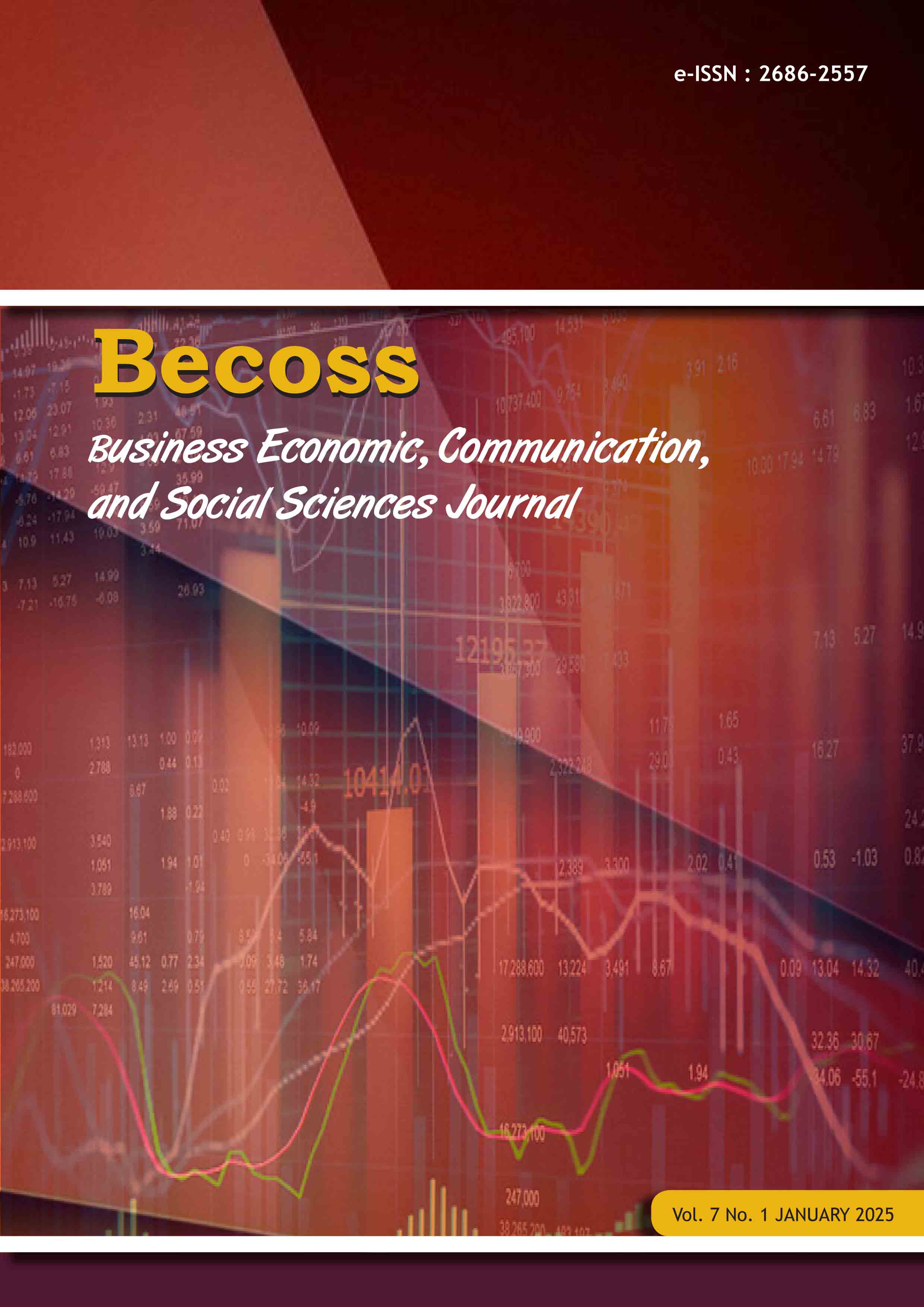Empowered or Overlooked? Examining the Role of Employment Status in Public Welfare Workers’ Self-Efficacy and Job Satisfaction
DOI:
https://doi.org/10.21512/becossjournal.v7i1.12437Keywords:
self-efficacy, job satisfaction, public social workers, employment status, social servicesAbstract
Employee well-being is crucial to organizational success, particularly in public service sectors where job satisfaction and self-efficacy directly impact performance. This study explores the relationship between self-efficacy, job satisfaction, and employment status among personnel from a public social welfare agency. A total of 215 employees, including 31 permanent, 53 contractual, and 131 contract of service workers, were randomly selected for participation. Data were collected using the New General Self-Efficacy Scale (NGSE) and the Minnesota Satisfaction Questionnaire (MSQ). Findings revealed consistently high levels of self-efficacy and job satisfaction across employment types, with no significant statistical differences between groups. A positive correlation was identified between self-efficacy and job satisfaction, indicating that employees with greater belief in their capabilities experience higher job fulfillment. However, this relationship was weaker among contractual employees, likely due to job insecurity. Moreover, the study highlights the vital role of social services and camaraderie in boosting self-efficacy and satisfaction, particularly during times of crisis. These findings imply that the nature of public social workers' jobs, which include assisting disadvantaged populations and delivering necessary services, naturally raises their levels of self-efficacy and job satisfaction across all job categories.
References
Alifuddin M., Widodo W. (2021) How social intelligence, integrity, and self-efï¬cacy affect job satisfaction: Empirical evidence from Indonesia. J Asian Finance, EconBus. 8(7):625–633. Principles and Methods of Research. https://doi.org/10.13106/JAFEB.2021.VOL8.NO7.062ARIOLA, M. M. (2006).
Bakker, A. B., & Demerouti, E. (2017). Job demands–resources theory: Taking stock and looking forward. Journal of Occupational Health Psychology, 22(3), 273–285. https://doi.org/10.1037/ocp0000056
Baloran, Erick and Hernan, Jenny Tabar (2020). Crisis Self-Efficacy and Work Commitment of Education Workers among Public Schools during COVID-19 Pandemic. https://doi.org/10.20944/preprints202007.0599.v1
Bandura A. (1997). Self-Efficacy: The Exercise of Control. Freeman. https://connect.springerpub.com/content/sgrjcp/13/2/158
Bandura, A. (1977). Self-Efficacy: Toward A Unifying Theory Of Behavioral Change. Psychological Review, 84(2), 191. https://doi.org/10.1037/0033-295X.84.2.191.
Baloran, E., & Hernan, J. T. (2020, July). Crisis self-efficacy and work commitment of education workers among public schools during COVID-19 pandemic. Preprints. Advance online publication. https://doi.org/10.20944/preprints202007.0599.v1
Bargsted, M., RamÃrez-Vielma, R., And Yeves, J. (2019). Professional Self-efficacy and Job Satisfaction: The Mediator Role of Work Design. Journal of Work and Organizational Psychology, 35, 157 - 163. https://doi.org/10.5093/jwop2019a18
Brahmannanda, S., & Dewi, I. M. (2020). Work insecurity and compensation on turnover intention mediated by employees' job satisfaction. International Research Journal of Management, IT and Social Sciences, 7(5), 89–98.
Çetin, F., and Aşkun, D. (2018). The effect of occupational self-efficacy on work performance through intrinsic work motivation. Manag. Res. Rev. 41, 186–201. https://doi.org/10.1108/MRR-03-2017-0062
Chen, G., Gully, S. M., & Eden, D. (2001). Validation of a new general self-efficacy scale. organizational research methods, 4(1), 62–83. https://doi.org/10.1177/109442810141004
Civil Service Commission Memorandum Circular No. 06, s.2012. Guidelines in the Establishment and Implementation of Agency Strategic Performance Management System. Civil Service Commission.
Civil Service Commission Memorandum Circular No. 03, s.2012. Program to Institutionalize Meritocracy and Excellence in Human Resource Management (PRIME-HRM). Civil Service Commission.
Cunnien, K. A., Martinrogers, N., & Mortimer, J. T. (2009). Adolescent Work Experience and Self-efficacy. The International Journal of Sociology and Social Policy, 29(3/4), 164. https://doi.org/10.1108/01443330910947534
Del Rosario, K., Botor, N. J., Padilla, J. J., Escobin, A., & Pelegrina, D. (2018). Work-Related Factors as Determinants of Self-efficacy and Resilience among Selected Filipino Child Development Workers. IAFOR Journal for Education.
Department of Social Welfare and Development [DSWD]. (2008). Amendment to Guidelines in the Implementation of the Character Building Program for Officials and Employees of the Department of Social Welfare and Development or MC No. 34, series of 2004. Administrative Order No. 004, Series of 2008.
Department of Social Welfare and Development. (2020). Enhanced Guidelines on the Deployment of the Quick Response Team. Administrative Order No. 02, Series of 2020.
Department of Social Welfare and Development [DSWD]. (2023). Guidelines on Flexible Work Schedule Arrangement. Administrative Order No. 11, Series of 2023.
Donkor, F. (2022). Do transformational leaders affect employee performance and normative commitment through general self-efficacy? Analysis in Ghanaian public sector organizations. Public Organization Review, 22(3), 707–723. https://doi.org/10.1007/s11115-021-00531-7
Dy, A., & et al. (2022). A double-edged sword: The effects of social network ties on job satisfaction among health care workers. PMC, 9709695.
Felfe, J., and Schyns, B. (2006). Personality and the perception of transformational leadership: the impact of extraversion, neuroticism, personal need for structure, and occupational self-efficacy 1. J. Appl. Soc. Psychol. 36, 708–739. https://doi.org/10.1111/j.0021-9029.2006.00026.x
Franta, B., Roa-Quiaoit, H. A., Lo, D., & Narisma, G. (2016, November). Climate disasters in the Philippines.
Gilovich, T., & Medvec, V. H. (1995). The experience of regret: What, when, and why. Psychological Review, 102(2), 379-395.
Han, J., Chu, X., Song, H., & Li, Y. (2014). Social capital, socioeconomic status, and self-efficacy. Applied Economics and Finance, 2(1), Article 607. https://doi.org/10.11114/aef.v2i1.607
Hechanova, M., Regina, M., & Caringal-Go, J. F. A. (2018). Building a culture of workplace wellness: Perspectives from Philippine organizations. International Journal of Research, 7(2), 71-83.
Hechanova, M. R. M., Caringal-Go, J. F., & Magsambol, G. (2018). Workplace engagement, motivation, and job satisfaction in the Philippine government sector. Philippine Journal of Psychology, 51(1), 1–25.
Herzberg, F. et al (1959). The motivation to work. John Willey and sons.
Işik, E. (2012). The relationship of career decision self-efficacy, trait anxiety, and affectivity among undergraduate students. Psychological Reports, 111(3), 805–813. https://doi.org/10.2466/01.09.10.PR0.111.6.805-813
Ilagan, J.R.A., Hechanova, M.R.M., Co, T.A.C., Pleyto, V.J.Z. (2014). “Bakit Ka Kumakayod?†Developing a Filipino Needs Theory of Motivation. Philippine Journal of Psychology.
Jiang, L., & Probst, T. M. (2019). The moderating effect of trust in management on consequences of job insecurity. Economic and Industrial Democracy, 40(2), 409-433. https://doi.org/10.1177/0143831X16652945
Jobstreet.com (2022). 70% of Filipino Employees Satisfied with Work. https://www.jobstreet.com.ph/career-resources/work-life-wellbeing/70-of-filipino-employees-satisfied-with work/#:~:text=According%20to%20JobStreet.com%20Philippines,percent%20who%20consider%20themselves%20unhappy.
Judge, T. A., Weiss, H. M., Kammeyer-Mueller, J. D., & Hulin, C. L. (2017). Job attitudes, job satisfaction, and job affect: A century of continuity and change. Journal of Applied Psychology, 102(3), 356–374. https://doi.org/10.1037/apl0000181
Ki, E.-J., & Nekmat, E. (2015). Decomposing impression from attitude in relationship management outcomes. Journal of Promotion Management, 4, 2–4.
Kim, S., & Wright, B. E. (2020). Public service motivation and job satisfaction: Exploring the role of work environment characteristics. Public Administration Review, 80(1), 89–103. https://doi.org/10.1111/puar.13132
Kumar, V., & Pansari, A. (2016). Competitive advantage through engagement. Journal of Marketing Research, 53(4), 497–514. https://doi.org/10.1509/jmr.15.0044
Lai, Ming-Cheng. (2012). Self-Efficacy, Effort, Job Performance, Job Satisfaction, and Turnover Intention: The Effect of Personal Characteristics on Organization Performance. International Journal of Innovation, Management and Technology. 3. https://doi.org/10.7763/IJIMT.2012.V3.260.
Laro, A. L. (2023). Resilient social work practice: From the experiences of Filipino social workers. ASEAN Social Work Journal, 11(2), 162.
Liu, D., Yang, X., Zhang, C., Zhang, W., Tang, Q., Xie, Y., & Shi, L. (2022). Impact of job satisfaction and social support on job performance among primary care providers in Northeast China: A cross-sectional study. Frontiers in Public Health, 10, 884955. https://doi.org/10.3389/fpubh.2022.884955
Locke, E.A. (1976) The nature and causes of job satisfaction. In: Dunnette, M.D., Ed., Handbook of Industrial and Organizational Psychology, Vol. 1, 1297-1343. https://www.scirp.org/(S(czeh2tfqyw2orz553k1w0r45))/reference/ReferencesPapers.aspx?ReferenceID=1639511
Lunenburg, Fred C. (2011). Self-Efficacy in the Workplace: Implications for Motivation and Performance. International Journal of Management, Business, and Administration, Volume 14, Number 1.
Medvec, V. H., Madey, S. F., & Gilovich, T. (1995). When less is more: Counterfactual thinking and satisfaction among Olympic medalists. Journal of Personality and Social Psychology, 69(4), 603-610.
Muchinsky, Paul M. (1989). Psychology applied to work. Second ed. Brooks/Cole.
Naratoma, I. B. I., & Sintaasih, D. K. (2022). The Role of Job Satisfaction in Mediation The Effect of Self-Efficacy and Job Insecurity on Turnover Intention. International Research Journal of Management, IT and Social Sciences, 9(4), 494–513. https://doi.org/10.21744/irjmis.v9n4.2108
Nguyen, H. Q., Van der Heijden, B. I. J. M., Le, H. T., & Van Vuuren, T. (2021). Job insecurity and employee well-being in public organizations: A meta-analysis. Review of Public Personnel Administration, 41(3), 425–452. https://doi.org/10.1177/0734371X20957781
Pangan, F., Hechanova, M. R., Franco, E.P., Mercado, R.H., Lopez, C.V. (2008). In R. Hechanova & E. Franco (Eds.), Leading Philippine organizations in a changing world (pp. 49-60).
Perry, J. L., & Wise, L. R. (1990). The motivational bases of public service. Public Administration Review, 50(3), 367–373. https://doi.org/10.2307/976618
Pinquart, M., Juang, L.P., Silbereisen, R.K. (2003). Self-efficacy and successful school-to-work transition: A Longitudinal Study. Journal of Vocational Behavior. pp. 329-346.
Pittâ€Catsouphes, M., & Mcnamara, T. (2019, January 25). Quality of employment and well-being: updating our understanding and insights. Edward Elgar Publishing. https://doi.org/10.4337/9781788113427.00033
Philippine Statistics Authority (2022). July 2022 Labor Force Survey. https://psa.gov.ph/content/employment-rate-july-2022-estimated-948-percent
Presidential Communications Office (2024). PBBM extends employment of COS, JO workers in gov’t. https://pco.gov.ph/news_releases/pbbm-extends-employment-of-cos-jo-workers-in-govt/
Ramadanti, S., Apriliani, L.A., & Kharisma (2023). The Impact of Employment Contract Status on Work Satisfaction and Productivity at PT. Mersifarma â„¢. https://10.2991/978-94-6463-226-2_25
Republic Act No. 10121. (2010). Philippine Disaster Risk Reduction and Management Act of 2010.
Salamat, Marya (2016). Aquino’s Legacy Proliferation of Contractual, Seasonal, Low-Quality Jobs.
Schunk, D. H. (1987). Peer models and children’s behavioral change. Review of Educational Research, 57(2), 149–174.
Schunk, D. H., & Zimmerman, B. J. (Eds.). (2008). Motivation and self-regulated learning: Theory, research, and applications. Lawrence Erlbaum Associates Publishers.
Schyns, B. (2004). The influence of occupational self-efficacy on the relationship of leadership behavior and preparedness for occupational change. J. Career Dev. 30, 247–261. https://doi.org/10.1177/089484530403000402
Stajkovic, A. D., & Luthans, F. (2018). Social cognitive theory and self-efficacy: Implications for motivation theory and practice. Organizational Behavior and Human Decision Processes, 147, 1–20. https://doi.org/10.1016/j.obhdp.2018.03.001
Tentama, F., & Abdillah, M. H. (2019). Student employability examined from academic achievement and self-concept. International Journal of Evaluation and Research in Education, 8(2), 243-248.
Ty, W. E. G., & Morga, A. D. S. (2020). Self-compassion, well-being, and happiness among Philippine employees. International Journal of Employment Studies, 28(2), 30–81. International Journal of Employment Studies
Ugwu, L. I., & Oji, I. (2013). Psychological contract breach, work-family conflict and self-efficacy as predictors of pro-social behaviour among a sample of Nigerian bank employees. Int. Rev. Soc. Sci. Human 6, 135–145.
Van Loon, N. M., Kjeldsen, A. M., Andersen, L. B., Vandenabeele, W., & Leisink, P. (2018). The role of public service motivation and job satisfaction in public employees’ job performance: A moderated mediation model. Social Service Review, 92(1), 3–34. https://doi.org/10.1086/696360
Wolomasi, A. K., Asaloei, S. I., & Werang, B. R. (2019). Job satisfaction and performance of elementary school teachers. International Journal of Evaluation and Research in Education, 8(4), 575–580.
Yao, K., Franco, E., & Hechanova, R. (2005). Rewards that matter: What motivates the Filipino employee? In R. Hechanova & E. Franco (Eds.), The way we work (pp.44-62).
Yao, J., Qui, X., Yang, L., Han, X., Li, Y. (2022). The Relationship Between Work Engagement and Job Performance: Psychological Capital as a Moderating Factor. https://doi.org/10.3389/fpsyg.2022.729131
Downloads
Published
How to Cite
Issue
Section
License
Copyright (c) 2025 Gene Kathlyn Aquino

This work is licensed under a Creative Commons Attribution-ShareAlike 4.0 International License.
Authors who publish with this journal agree to the following terms:
- Authors retain copyright and grant the journal right of first publication with the work simultaneously licensed under a Creative Commons Attribution License - Share Alike that allows others to share the work with an acknowledgment of the work's authorship and initial publication in this journal.
- Authors are able to enter into separate, additional contractual arrangements for the non-exclusive distribution of the journal's published version of the work (e.g., post it to an institutional repository or publish it in a book), with an acknowledgment of its initial publication in this journal.
- Authors are permitted and encouraged to post their work online (e.g., in institutional repositories or on their website) prior to and during the submission process, as it can lead to productive exchanges, as well as earlier and greater citation of published work.
USER RIGHTS
All articles published Open Access will be immediately and permanently free for everyone to read and download. We are continuously working with our author communities to select the best choice of license options, currently being defined for this journal as follows: Creative Commons Attribution-Share Alike (CC BY-SA)






